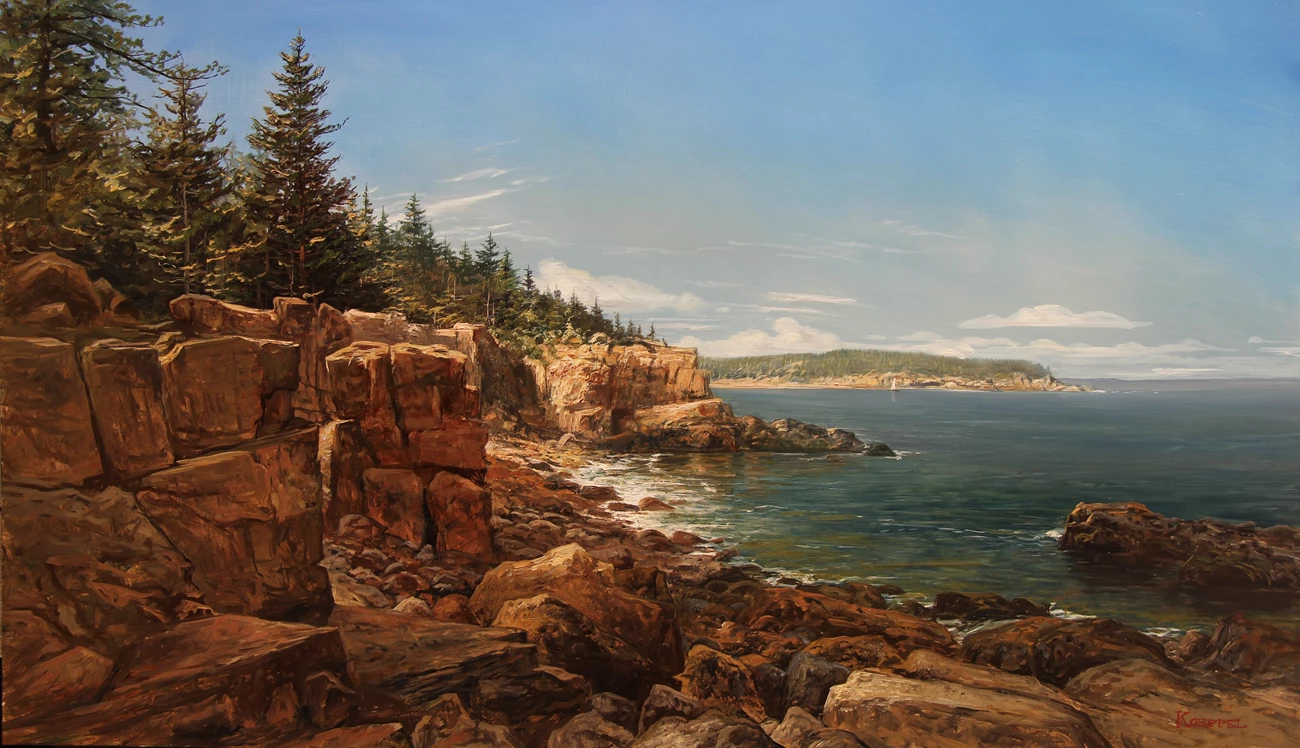Last updated: September 18, 2020
Article
Artists Inspire Creation of Acadia

Photo courtesy of Erik Koeppel. Used with permission.
by James Zordan
Standing on the cliffs at Otter Point and looking back at the strikingly bold coastline, it’s easy to be overcome by the power and beauty of this landscape. This feeling is precisely what drew early artists to visit Mount Desert Island and what we now know of as Acadia National Park in the mid 1800’s who were looking to find inspiration for their paintings.
At this time there was a new school of art which emerged in New York called the Hudson River School of Artists. These painters sought to capture the idea that American landscapes were something to be revered not because they could be tamed or subdued, but because the powerful forces of nature deserved to be highlighted and respected.
Part of the American National Identity at the time was to celebrate the pristine forests and mountains of our country. Europeans had many great monuments celebrating different aspects of their culture, Americans felt that our monuments were found in the relatively untouched wilderness of our nation. It was the work of these Hudson River School artists that first drew tourists to Acadia National Park and ultimately helped to preserve and protect this landscape.
After returning from an exhibition on landscape paintings in May of 1847, a reviewer for the New York Literary World wrote, "Yankee enterprise has little sympathy with the picturesque, and it behooves our artists to rescue from its grasp the little that is left before it is forever too late. This is their mission." Perhaps it was sentiments like these that inspired painters such as Thomas Cole, Fitz Hugh Lane, and Frederick Church to explore the coast of Maine in the mid 1800’s. Thomas Cole was one of the first and most well-known artists to travel to this region, creating such works as "View Across Frenchman’s Bay from Mt Desert Island, After a Squall." This painting, which captures the forceful energy of the Atlantic Ocean, inspired one of his pupils, Frederic Church, to visit Mount Desert Island and create his own vast collection of sketching’s and paintings of the area.
"Yankee enterprise has little sympathy with the picturesque, and it behooves our artists to rescue from its grasp the little that is left before it is forever too late. This is their mission."
– New York Literary World, 1847
Following in the footsteps of Cole and Church came other artists such as Clement Drew, Julia Whiting, and Sanford Robinson Gifford who sought to capture the relatively unknown beauty of Mount Dessert Island. When these artists exhibited their work in major cities such as Boston, New York, and Philadelphia, the public was immediately drawn to this area, and for those seeking to escape the industrialized cities of the time the pristine beauty of the Maine coastline was an enticing haven.
Mount Desert Island went from being a relatively unknown and sparsely populated island to one of the premier tourist destinations in the country in less than a decade. In 1867, two years after Church’s last great painting of the island was exhibited in New York, Clara Barnes Martin published a travel guide titled Mount Desert on the Coast of Maine and ever since then the fate of this island was forever changed as visitors sought to experience this place for themselves
The influence of artists to draw people to this stunning landscape continues to this day. Acadia National park is one of more than 50 parks which have Artist-in-Residence Programs. Since 1993 Acadia has hosted more than 100 artists including painters, writers, sculptors, dancers, and composers from all over the country who have come here to be inspired. These artists come here not only to showcase the beauty of this place, but in order to connect visitors to this pristine environment.
